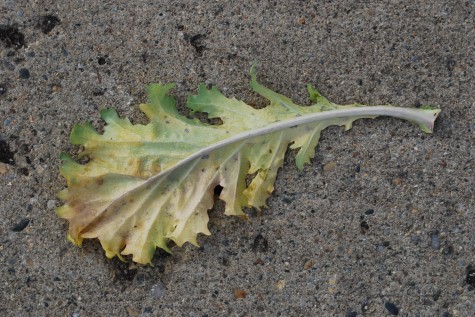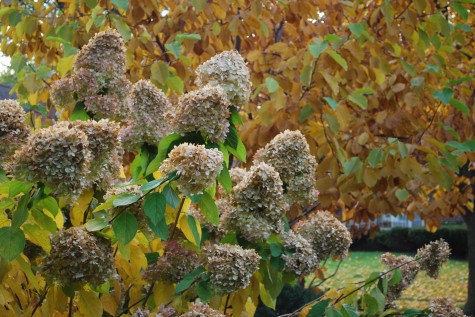 The fall is the perfect time to talk about light as an element of design in the landscape. How, when and where the sun shines, dramatically influences the visual impact of any landscape or garden. October light in Michigan is cold and low in the sky. Uneven or carved surfaces are cast in sharp relief. Any shadows cast will be dramatically elongated. A client choosing a smooth surfaced ornament for their garden should be happy for a subtle light rendering; if not, choosing ornament with some more graphic surface variation might be in order.
The fall is the perfect time to talk about light as an element of design in the landscape. How, when and where the sun shines, dramatically influences the visual impact of any landscape or garden. October light in Michigan is cold and low in the sky. Uneven or carved surfaces are cast in sharp relief. Any shadows cast will be dramatically elongated. A client choosing a smooth surfaced ornament for their garden should be happy for a subtle light rendering; if not, choosing ornament with some more graphic surface variation might be in order.
 I could write on into the next decade about how light is the engine that gets any outdoor space moving. One of my favorite parts of my Michigan gardening life is how the light can make the appearance of everything change, from hour to hour, and day to day, and season to season. The contrast of light and dark in a garden is its heartbeat. In October, the trees coloring up are all the more dramatic for the ignition supplied by that intensely pale light. Its worth thinking about the degree of shade a tree or shrub will cast in a landscape. A densely shady area is all the more dramatic with a pocket pool of light behind it. Plan for dark spaces close to your view, with light spaces in the distance.
I could write on into the next decade about how light is the engine that gets any outdoor space moving. One of my favorite parts of my Michigan gardening life is how the light can make the appearance of everything change, from hour to hour, and day to day, and season to season. The contrast of light and dark in a garden is its heartbeat. In October, the trees coloring up are all the more dramatic for the ignition supplied by that intensely pale light. Its worth thinking about the degree of shade a tree or shrub will cast in a landscape. A densely shady area is all the more dramatic with a pocket pool of light behind it. Plan for dark spaces close to your view, with light spaces in the distance.
 The spring leaves emerging on my Princeton gold maples cannot hold a candle to their yellow fall fire. I am a photographer whose lack of understanding about the mechanics of photography is considerable. So I watch the light. When it suffuses every element in a garden such that the color in my pictures, or the feeling of my pictures, will be saturated-that is the time I photograph. I record; I do not have the skills to generate. It is hard to believe this collection of these maple yellow leaves produces such dense shade underneath; the grey cedar fence appears black by way of contrast, and almost disappears.
The spring leaves emerging on my Princeton gold maples cannot hold a candle to their yellow fall fire. I am a photographer whose lack of understanding about the mechanics of photography is considerable. So I watch the light. When it suffuses every element in a garden such that the color in my pictures, or the feeling of my pictures, will be saturated-that is the time I photograph. I record; I do not have the skills to generate. It is hard to believe this collection of these maple yellow leaves produces such dense shade underneath; the grey cedar fence appears black by way of contrast, and almost disappears.
 Our thin rod steel spheres permit the view of your choice through to the landscape. How they interact with a garden is the best part about them. Imagine this view in the winter, the early spring, the early summer, the high summer, the fall; you get the idea. Add light to the mix, and your possible visual combinations increase considerably. Garden ornament interests me greatly, given how it offers me a sense of solidity, and steadfast longevity, against the ever changing landscape.
Our thin rod steel spheres permit the view of your choice through to the landscape. How they interact with a garden is the best part about them. Imagine this view in the winter, the early spring, the early summer, the high summer, the fall; you get the idea. Add light to the mix, and your possible visual combinations increase considerably. Garden ornament interests me greatly, given how it offers me a sense of solidity, and steadfast longevity, against the ever changing landscape.
 The bright flat October sun sets all it touches on fire. The greens are all that much more electrically green; the reds glow red. If you are looking to see the rhythm established by the masses of light and dark in your landscape, look quick now before the leaves fall. There is instruction coming from the natural world every day, should you care to tune in.
The bright flat October sun sets all it touches on fire. The greens are all that much more electrically green; the reds glow red. If you are looking to see the rhythm established by the masses of light and dark in your landscape, look quick now before the leaves fall. There is instruction coming from the natural world every day, should you care to tune in.
 The color of these pansies speaks softly in the spring. The fall light intensifies and electrifies the appearance of their color. On my best days, I think about how the light will fall on a landscape in every season, as this should influence how I place every plant or object.
The color of these pansies speaks softly in the spring. The fall light intensifies and electrifies the appearance of their color. On my best days, I think about how the light will fall on a landscape in every season, as this should influence how I place every plant or object.

No annual or perennial in my garden has color quite like this. It interests me that at the moment the color of the leaves of this Boston ivy flares brightly, the leaves are also beginning to decompose. Life and death inextricably intertwined. Though my idea of hell places me in a history of philosophy classroom, I have no problem walking outside, and observing what is going on. 
Those brightly cold moments in October forecast the dormant season on the way. The light is bluish; it throws everything silhouetted against it black. The soft grey of the bark of my lindens reads flat black in the fall. It’s the quality of the light transforming a landscape you thought you knew, into something you have not seen before.

This cabbage leaf shed from its plant is plastered on the concrete in a fall rain. The cool light records the dropping of the leaves; it takes you and I to wake up and see it. The smooth green stem gone a grief stricken pale grey reads graphically against the wet dark pavement. This is a different version of October light.

This last stage of the flowers of my hydrangeas, bathed in October light-so beautiful. Maybe more beautiful than the height of their bloom. They look so dignified, as they gracefully dry, quietly accepting the closing of the season. The October light makes an operatic production of this process, does it not? I would encourage you-see the light.
I found myself outside with my camera yesterday afternoon. The sun was out and my oak tree is just such a vibrant yellow right now. It all happens so quickly that I wanted to capture it before they fall away.
Food for thought. The interplay of light and dark is yet another consideration in planning the garden… though in a city garden like mine, it’s something I don’t entirely have power over. Large Norway maples shade my little plot on either side. However, I’ll think more strenuously on the subject as I try to reshape my space in 2010. Thanks, as ever, for your insights.